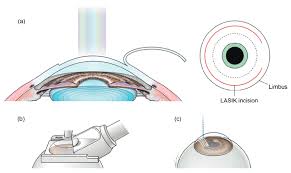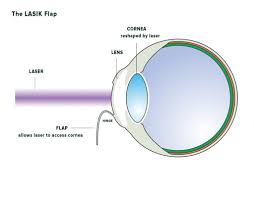Table of Contents
ToggleIn our rapidly evolving world, convenience and efficiency have become essential.
Whether it’s for work, leisure, or personal comfort, having clear vision without the hassle of glasses or contact lenses can be a game-changer.
Enter LASIK (Laser-Assisted In Situ Keratomileusis), a popular surgery that promises to free you from the daily grind of eyewear.
But with costs ranging between INR 50,000 to INR 1,00,000, many wonder, “Is LASIK worth the money?”
This blog explores the ins and outs of LASIK surgery, providing you with comprehensive information to help you make an informed decision.
Understanding LASIK
LASIK is a type of refractive eye surgery that corrects common vision problems such as myopia (nearsightedness), hyperopia (farsightedness), and astigmatism. The procedure entails the reshaping of the cornea—the transparent anterior segment of the eye—utilizing a laser. This process enables light entering the eye to be accurately focused onto the retina, resulting in enhanced visual clarity.
How LASIK Works?
The LASIK procedure is relatively quick, often completed within 30 minutes for both eyes. Here’s a step-by-step breakdown:
1. Preparation:
- Your eye surgeon will perform a thorough eye exam to ensure your eyes are healthy enough for the procedure.
- They will also map the shape of your cornea using a corneal topographer.
- Numbing drops are applied to minimise discomfort during the procedure.
2. Creating the Flap:
- A microkeratome (a precise surgical instrument) or a femtosecond laser creates a thin, circular flap in the cornea.
- The surgeon subsequently repositions the flap to gain access to the underlying cornea.
3. Reshaping the Cornea:
- An excimer laser is used to remove corneal tissue, reshaping it according to the specific measurements taken during your eye exam.
- For nearsighted individuals, the cornea is flattened; for farsighted individuals, it is made steeper; and for astigmatism, the irregular cornea is smoothed into a more normal shape.
4. Repositioning the Flap:
- The corneal flap is then laid back in place, covering the area where the corneal tissue was removed. It adheres naturally without the necessity for stitches.
Benefits of LASIK
Immediate Results
One of the most appealing aspects of LASIK is the immediacy of its results. Most patients notice improved vision within 24 hours, and many achieve 20/20 vision or better post-surgery. Imagine waking up the next morning and seeing the world clearly without reaching for your glasses!
Long-Term Cost Savings
While the upfront cost of LASIK may seem steep, consider the long-term savings. Glasses and contact lenses can add up over the years:
Glasses:
- Average cost per pair (with prescription lenses): INR 2,000- INR 4,000.
- If you replace your glasses every two years, over 30 years, you could spend anywhere from INR 30,000 to INR 60,000.
Contact Lenses:
- Monthly disposable lenses cost around INR 1,000 to INR 5,000 per year.
- Over 30 years, this adds up to INR 30,000- INR 1,50,000.
In comparison, a one-time payment for LASIK could save you thousands of rupees in the long run.
Convenience and Quality of Life
No more fumbling for glasses in the morning or dealing with the discomfort of contact lenses. LASIK provides the freedom to engage in activities like swimming, sports, and outdoor adventures without the limitations of corrective eyewear.
Plus, many people find that their confidence and self-esteem improve with their new clear vision.
Safety and Success Rates
LASIK is one of the most studied elective procedures, boasting a high success rate. According to the American Refractive Surgery Council, over 96% of patients are satisfied with the results. Complications are rare, and advances in technology have made the procedure even safer and more effective.
Potential Risks and Drawbacks
Despite its many advantages, LASIK is not without risks. It is imperative to take these potential drawbacks into account prior to making a decision.
Side Effects
Some patients experience side effects post-surgery, which may include:
- Dry Eyes:
Many patients experience dry eyes temporarily after LASIK. In the majority of instances, this typically resolves within a few months.
- Glare, Halos, and Starbursts:
Some patients report seeing glare, halos around lights, or starbursts in low-light conditions. These symptoms usually decrease over time.
- Flap Complications:
Issues with the corneal flap can occur, including infection or inflammation. Nonetheless, these complications are infrequent and can typically be managed effectively.
Not Suitable for Everyone
LASIK is not suitable for individuals with certain medical conditions or specific eye issues:
- Unstable Vision:
If your prescription has changed significantly in the past year, LASIK may not be recommended until your vision stabilises.
- Corneal Thickness:
Individuals with thin corneas may not be good candidates for LASIK.
- Autoimmune Disorders:
Conditions like rheumatoid arthritis or lupus can interfere with healing post-surgery.
Cost Considerations
The cost of LASIK can be prohibitive for some, and insurance typically does not cover the procedure since it’s considered elective. Nevertheless, numerous clinics provide financing options to facilitate more manageable costs.
Evaluating If LASIK Is Right for You
Personal Vision Goals
Consider your personal vision goals and lifestyle:
- Are you fatigued by the daily inconvenience of glasses or contact lenses?
- Do you engage in activities where glasses or contacts are a hindrance?
- Are you looking for a long-term solution to correct your vision?
Medical Consultation
A thorough consultation with an experienced eye surgeon is essential. They will evaluate your eye health, discuss your vision goals, and determine if you are a suitable candidate for LASIK.
Cost-Benefit Analysis
Conduct a cost-benefit analysis considering both the financial and quality-of-life aspects. While the upfront cost may be high, the long-term savings and convenience could make it a worthwhile investment.
Alternatives to LASIK
If LASIK isn’t suitable for you, there are alternative vision correction options:
PRK (Photorefractive Keratectomy)
PRK is similar to LASIK but involves removing the outer layer of the cornea (epithelium), which then regenerates over time. PRK may be a better option for those with thin corneas or other contraindications for LASIK.
LASEK (Laser Epithelial Keratomileusis)
LASEK combines elements of both LASIK and PRK. The epithelium is loosened with alcohol before being moved aside, and then the underlying corneal tissue is reshaped with a laser.
SMILE (Small Incision Lenticule Extraction)
SMILE is a minimally invasive procedure where a small incision is made in the cornea, and a lenticule (small piece of corneal tissue) is removed to reshape the cornea. This option can be suitable for those with higher degrees of myopia.
Implantable Collamer Lens (ICL)
ICL involves implanting a lens inside the eye between the iris and the natural lens. This is a reversible procedure and can be a good option for those with severe refractive errors.
Key Takeaways
The question “Is LASIK worth the money?” ultimately hinges on your unique circumstances, vision objectives, and lifestyle choices. LASIK offers numerous benefits, including immediate results, long-term cost savings, convenience, and high success rates. However, it’s essential to weigh these benefits against potential risks and financial investment.
If you’re considering LASIK, schedule a consultation with a reputable eye surgeon to discuss your options and determine if you’re a good candidate. Additionally, explore alternative vision correction methods if LASIK isn’t suitable for you.
Remember, clear vision is invaluable, and investing in your eyesight can significantly enhance your quality of life. Whether through LASIK or another procedure, achieving freedom from glasses or contact lenses can be a life-changing experience.
Ready to explore the possibilities of LASIK? Contact a certified LASIK eye surgeon today to take the first step towards clearer vision.













